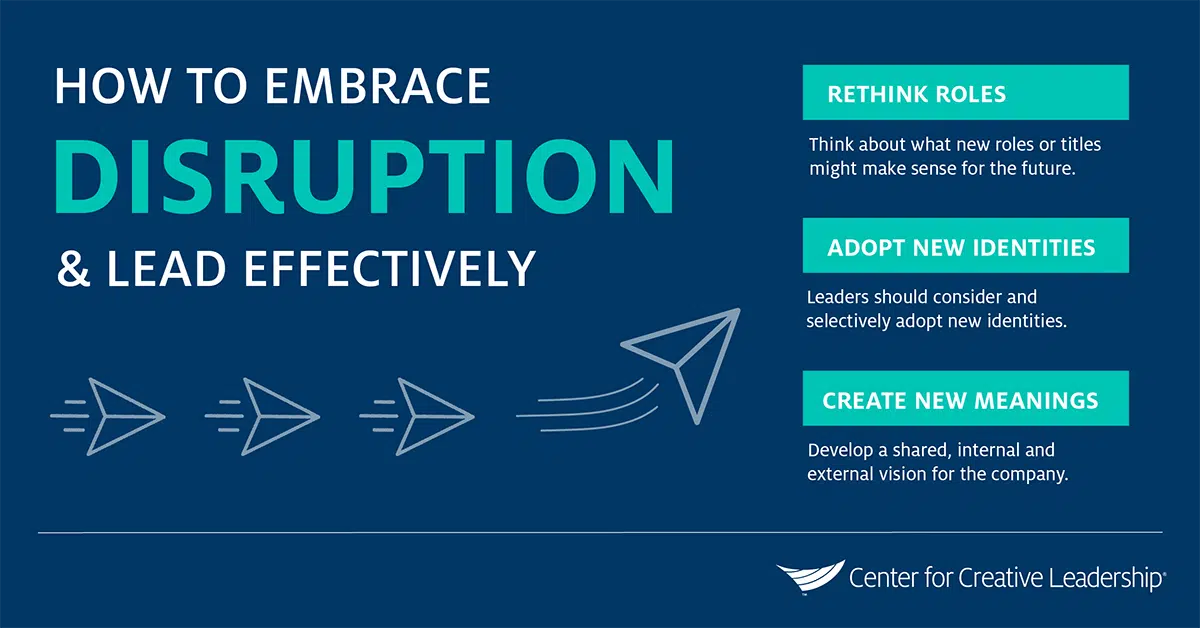To Succeed, Leaders Must Embrace Disruption
As the world braces itself for an uncertain future with the global pandemic and its economic aftermath, we’re reminded of the military’s term “VUCA” (Volatility, Uncertainty, Complexity, and Ambiguity), shorthand for describing just this kind of difficult environment.
Business models that carried companies to the top of their industries are burning, set aflame by unexpected economic shifts, changing technology, demographic changes, globalization, and other disruptive forces. Consider, for example, how technology has transformed the music business from CDs to audio downloads to on-demand streaming in just 2 decades. Nokia lost market share of global cell phone sales when Apple hit the market with game-changing design. Everyone’s aware of stories like these.
Yet to truly lead their organizations through disruption, leaders themselves must change. You need to disrupt your leadership.
Tips for Leading Through Disruption
For organizations to survive and thrive, their leaders must be adept at adopting new roles, crafting new identities, and finding new meaning for themselves and those they lead. Here are the 3 shifts needed, which we outline in our white paper:
3 Key Shifts for Embracing Disruption
1. Rethink your role.
The first big shift is for leaders to disrupt their roles. Organizations of the future may look very different than most organizations do today.
For example, a consumer electronics and home appliance company might decide to transform its workforce so it can better monitor, and respond to, changing consumer trends. As a result, it might reorganize itself into 2,000 independent units, each with its own P&L, and pay employees based on performance.
In such an instance, the CEO’s own role must also change. Instead of sitting atop a giant organizational hierarchy, the top executive must now manage many interdependent business units as they respond to market forces. Perhaps instead of “Chief Executive Officer,” a better title might be Chief Ecosystem Officer. Other senior executives likewise might take on new roles and new responsibilities to keep the organization stable, while at the same time making it more agile.
Consider whether you’re helping to drive forward innovation at your organization, given where you sit.
2. Adopt new identities.
The second big shift for leaders is to disrupt their identities. While traditional identities — such as “the visionary” and “the performance-driven” — will remain relevant, leaders should consider and selectively adopt new identities.
- Be a consumer: Consumer experience can help you develop new and better ideas. Seek out firsthand insights into how consumers use and experience digital tools.
- Be a catalyst: Nonstop iterations within the innovation process can drive organizational transformation in strategy, organization, and market presence.
- Be a mad scientist: Experimenting in creative ways and taking calculated risks can help you explore possibilities that will help you understand the tumultuous environment your organization is operating within and how to succeed in that environment.
3. Create new meanings.
The third shift comes when leaders start creating new meaning. Purpose is a key component of many companies’ strategies now — consider Facebook’s mission “to give people the power to build community and bring the world closer together,” for example.
Developing a shared sense of meaning within and outside of a company is a powerful tool for shaping culture, driving innovation, and creating a sustainable organization. This job of “creating meaning” for an organization is one of the most important functions a leader has.
Leaders can consider their organization’s meaning through 3 dimensions:
- Personal: Individuals can receive functional and emotional benefits from products and services that are infused with meaning.
- Organizational: A strong sense of purpose creates tangible and intangible value for the organization and its stakeholders.
- Societal: Your organization’s meaning and purpose can influence — directly and indirectly — society as a whole.
Leaders who create a unifying vision across all 3 dimensions of meaning can drive extraordinary success for their companies. This is key to becoming a more resilient organization.
How to Lead Through Disruption
As employees adapt to a new way of life centered around self-isolation, working from home, and rethinking even basic daily transactions, their organizations are focused on the third shift — creating new meaning and purpose.
For example, how can organizations reshape their culture when employees are furloughed and positions are eliminated? How can the employees who are left with double — and sometimes triple — the job responsibilities recast their skills to do more with less? How can executives drive innovation in an environment where customers have evolving needs?
Seizing this moment, leaders have an opportunity to create a unifying vision to drive the future success of their companies.
Auto parts maker Delphi is a good example. The company was spun off from General Motors in 1999, but changes to the auto industry and high legacy costs pushed the firm into bankruptcy by 2005. To find its way out, it was critical for the company to find new meaning and purpose.
A new culture was forged based on excellence and a passion for customers. As the auto industry embraced new technologies, such as electrical and self-driving vehicles, Delphi carried out a strategy to develop new technologies to make the world safer, greener, and more connected.
When the company went public in 2011, it was worth less than $3 billion. In 2017, it split into 2 companies: Delphi Technologies, which was worth about $4.5 billion in early 2018, and Aptiv PLC, worth more than $24 billion.
“If you are in business, you will face disruption and change,” said Majdi B. Abulaban, president of Delphi E/EA, Delphi Engineered Components Group & Delphi Asia Pacific.
“Find meaning in what is happening around you. Only then can you explain it and have people embrace it with a common purpose. Only then can you reinvent yourself.”
Ready to Take the Next Step?
Help your people learn to embrace disruption and adapt to change effectively with a customized learning journey for your leaders using our research-backed modules. Available leadership topics include Communication, Conflict Resolution, Emotional Intelligence, Innovation Leadership, Leading Through Change & Disruption, Psychological Safety, and more.










